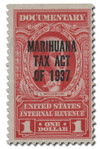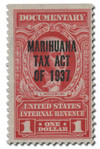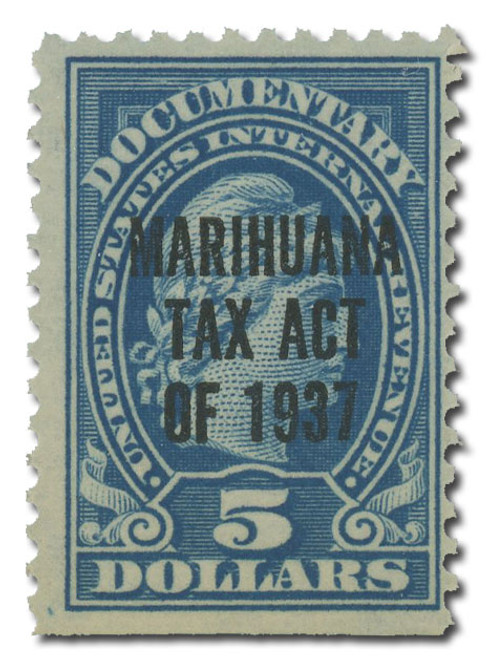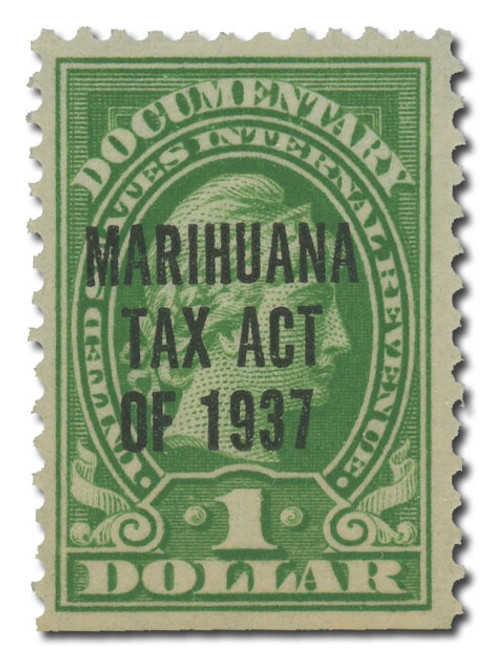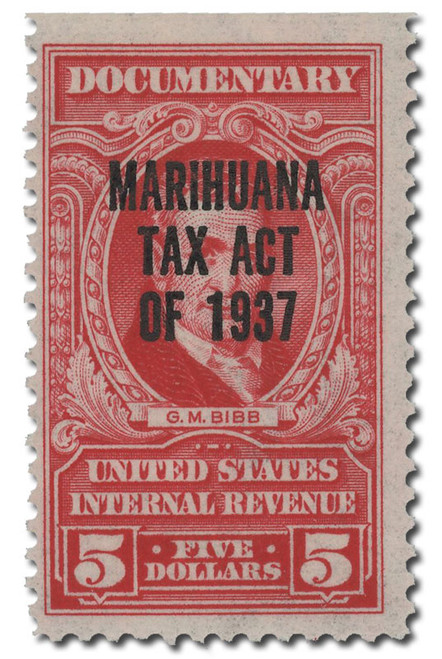
# RJM5 - 1962 $1 Carmine 2nd Issue Marihuana
2nd Issue Marihuana Tax Stamps
Marihuana Tax Act of 1937
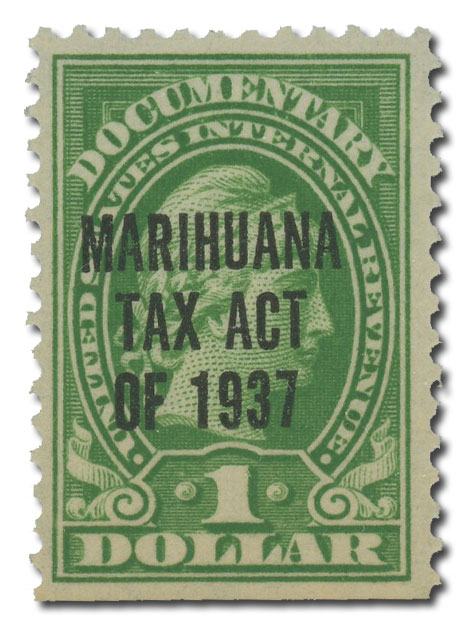
On August 2, 1937, President Franklin Roosevelt signed the Marihuana Tax Act of 1937 into law. The act required all producers, laboratories, dealers, importers, and doctors to register each year to legally buy and sell marijuana.
At the beginning of the 20th century, marijuana was legal for medicinal and research purposes. However, as the century went on, more people began using it for more than just medical necessity.  The Federal government was faced with growing use of recreational marijuana and no authority to criminalize the substance. The federal government couldn’t outlaw marihuana or other drugs – only individual states could do that.
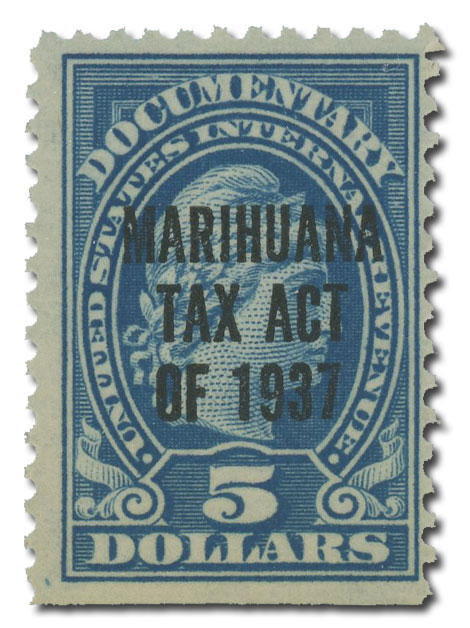
Harry Anslinger, the first commissioner of the Federal Bureau of Narcotics, drafted the Marihuana Tax Act of 1937.  He had noted an increase in the number of people smoking marijuana and felt something needed to be done on a Federal level. At a Congressional hearing, he said, “Traffic in marihuana is increasing to such an extent that it has come to be cause for the greatest national concern.â€Â Anslinger referred to the International Opium Convention of 1928, which classified marijuana (or cannabis) as a drug, not a medicine. The American Medical Association disagreed with the bill, and the lawyer representing the association doubted Anslinger’s reports of marijuana usage leading to violence and addiction. Also, the use of the term “marijuana†was not common at the time, and most doctors knew the substance as cannabis.
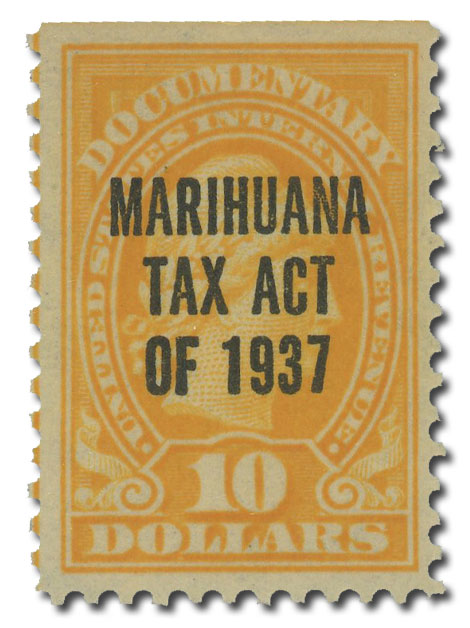
Regardless, the act was passed on August 2, 1937. The Marijuana tax was applied in five different categories. Producers paid a $1 tax, prescribing practitioners paid $1, laboratories paid $1, dealers paid $3, and importers, manufacturers, and compounders paid $24. Each ounce of marijuana was taxed an additional $1 when sold to a registered individual. Special tax stamps, which looked similar to licenses, were the receipts for the payment of these annual taxes. Some of the most common of these stamps are those used by producers of marijuana. The first Marijuana stamps were Series of 1914 Documentary Stamps overprinted with “Marihuana Tax Act of 1937.â€

Those who couldn’t meet the strict registration criteria (recreational drug users) were taxed $100 per ounce. Failure to comply was punishable by five years in prison and a $2,000 fine. This $100 tax was very expensive. Plus, purchasing the stamp would be self-incriminating in the states where it was illegal. In the 33 years that the act was in place, there wasn’t a single application for the $100 stamp. The first tax evasion arrests were made the day after the act went into effect on October 1, 1937.
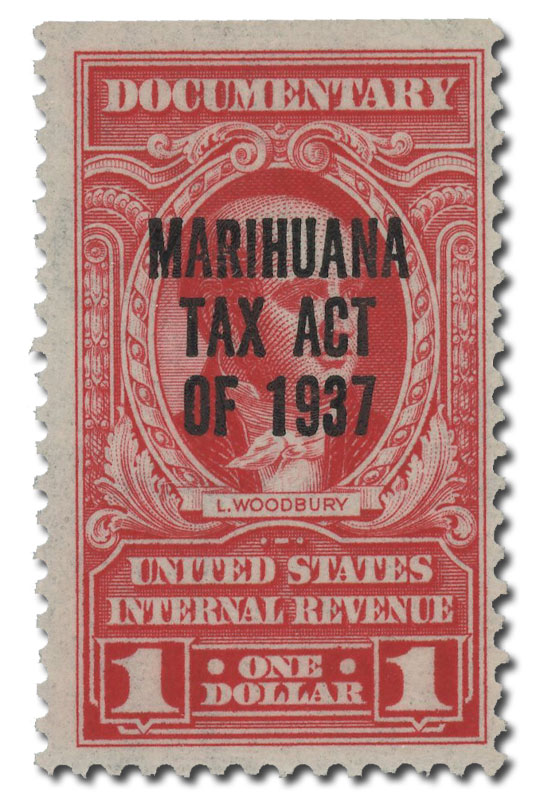
Marihuana stamps were issued in especially large numbers during World War II to farmers who grew hemp, a plant containing a small amount of cannabis (another name for marijuana). The plant was used to produce hawsers (rope) for the US Navy. In fact, the US government ran a hemp factory in Rockford, Iowa.

In 1965, Timothy Leary, a psychologist who advocated using drugs to expand a person’s consciousness, was arrested for possession of marijuana. He was convicted under the Marihuana Tax Act, sentenced to 30 years in prison, and fined $30,000. Leary appealed the case on the grounds that he would have incriminated himself if he had paid the tax, which violated the Fifth Amendment. The Supreme Court agreed with him and declared the act unconstitutional. Congress then repealed the act and passed the Controlled Substances Act of 1970, including marijuana in the list of drugs with a high potential for abuse.
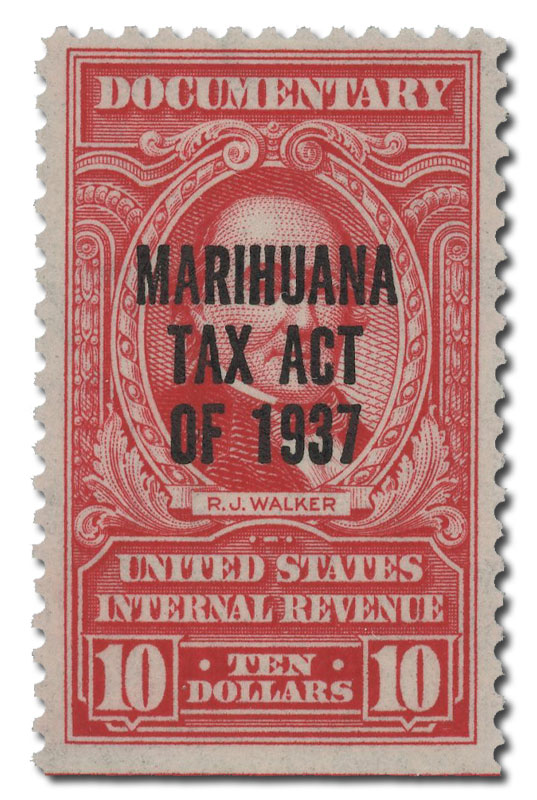
Because the strict government regulations made it nearly impossible to get the Marihuana stamps, only a handful ever found their way into private collections. Marihuana Tax stamps are so scarce they were not listed in the Scott Catalogue until 2006 – so most collectors never knew they existed.
2nd Issue Marihuana Tax Stamps
Marihuana Tax Act of 1937

On August 2, 1937, President Franklin Roosevelt signed the Marihuana Tax Act of 1937 into law. The act required all producers, laboratories, dealers, importers, and doctors to register each year to legally buy and sell marijuana.
At the beginning of the 20th century, marijuana was legal for medicinal and research purposes. However, as the century went on, more people began using it for more than just medical necessity.  The Federal government was faced with growing use of recreational marijuana and no authority to criminalize the substance. The federal government couldn’t outlaw marihuana or other drugs – only individual states could do that.

Harry Anslinger, the first commissioner of the Federal Bureau of Narcotics, drafted the Marihuana Tax Act of 1937.  He had noted an increase in the number of people smoking marijuana and felt something needed to be done on a Federal level. At a Congressional hearing, he said, “Traffic in marihuana is increasing to such an extent that it has come to be cause for the greatest national concern.â€Â Anslinger referred to the International Opium Convention of 1928, which classified marijuana (or cannabis) as a drug, not a medicine. The American Medical Association disagreed with the bill, and the lawyer representing the association doubted Anslinger’s reports of marijuana usage leading to violence and addiction. Also, the use of the term “marijuana†was not common at the time, and most doctors knew the substance as cannabis.

Regardless, the act was passed on August 2, 1937. The Marijuana tax was applied in five different categories. Producers paid a $1 tax, prescribing practitioners paid $1, laboratories paid $1, dealers paid $3, and importers, manufacturers, and compounders paid $24. Each ounce of marijuana was taxed an additional $1 when sold to a registered individual. Special tax stamps, which looked similar to licenses, were the receipts for the payment of these annual taxes. Some of the most common of these stamps are those used by producers of marijuana. The first Marijuana stamps were Series of 1914 Documentary Stamps overprinted with “Marihuana Tax Act of 1937.â€

Those who couldn’t meet the strict registration criteria (recreational drug users) were taxed $100 per ounce. Failure to comply was punishable by five years in prison and a $2,000 fine. This $100 tax was very expensive. Plus, purchasing the stamp would be self-incriminating in the states where it was illegal. In the 33 years that the act was in place, there wasn’t a single application for the $100 stamp. The first tax evasion arrests were made the day after the act went into effect on October 1, 1937.

Marihuana stamps were issued in especially large numbers during World War II to farmers who grew hemp, a plant containing a small amount of cannabis (another name for marijuana). The plant was used to produce hawsers (rope) for the US Navy. In fact, the US government ran a hemp factory in Rockford, Iowa.

In 1965, Timothy Leary, a psychologist who advocated using drugs to expand a person’s consciousness, was arrested for possession of marijuana. He was convicted under the Marihuana Tax Act, sentenced to 30 years in prison, and fined $30,000. Leary appealed the case on the grounds that he would have incriminated himself if he had paid the tax, which violated the Fifth Amendment. The Supreme Court agreed with him and declared the act unconstitutional. Congress then repealed the act and passed the Controlled Substances Act of 1970, including marijuana in the list of drugs with a high potential for abuse.

Because the strict government regulations made it nearly impossible to get the Marihuana stamps, only a handful ever found their way into private collections. Marihuana Tax stamps are so scarce they were not listed in the Scott Catalogue until 2006 – so most collectors never knew they existed.



